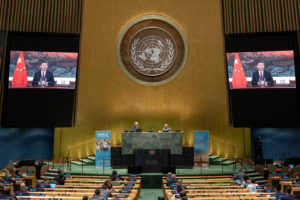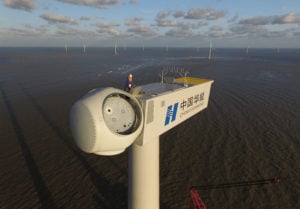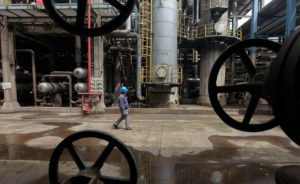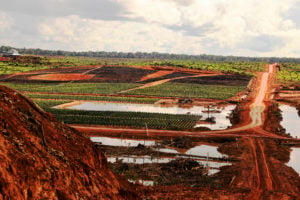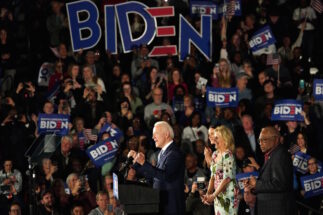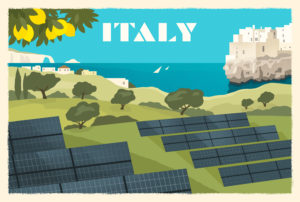On 12 December 2015, Carlos Fuller sat down in a room at the UN climate talks in Paris, known as COP21, with others from the Alliance of Small Island States (AOSIS) negotiating group, to study the proposed final text of the Paris Agreement.
It was a key moment for global climate action. After years of preparation and an exhausting two weeks of negotiations, would countries finally agree on the much-anticipated deal?
Having analysed it, “we came out quite satisfied with the outcome”, recalls Fuller, who at the time was lead climate negotiator for Belize and climate coordinator for the Caribbean Community group of countries. Now lead climate negotiator for AOSIS, Fuller says: “I remember people breaking out into a calypso, celebrating the fact that it had been achieved. And we were hoping that the other groups, the African group, and so on, would also agree with it. Which in fact was the case.”
The Paris deal, adopted later that evening, was met with jubilation in the plenary, the celebratory afterparties in Paris that night, and around the world.
The agreement marked the first major accord to cut global emissions since the Kyoto Protocol was adopted in 1997, but it was an entirely different deal to those that had come before it.
After a calamitous collapse of negotiations on a climate deal at the 2009 UN talks in Copenhagen, diplomats had been forced into a major rethink over how to structure a global climate accord that all countries would be willing to sign up to. “There was so much expectation built up for Copenhagen, that the agreement would be reached there,” says Tasneem Essop, head of WWF’s delegation to the Paris talks and now executive director of Climate Action Network (CAN). “And so post-Copenhagen, there was a very different understanding of what was possible and what was not possible.”
Instead of negotiating top-down country climate targets, the Paris Agreement set out a wider framework for action that would see countries make voluntary pledges that would be ramped up every five years. The world is currently at the end of the first cycle of these pledges, which is why countries were being pushed on the weekend to fulfil their commitments and submit new climate goals, although informally there appears to be some leeway on the deadline due to the impacts of Covid-19.
Another key change from Kyoto was that the Paris Agreement expected climate pledges from all countries – not only developed ones. But developing countries were still pushing for serious recognition that developed countries needed to lead and take the deepest and fastest emissions cuts. “The issue of equity was absolutely paramount to address,” says Yamide Dagnet, director of climate negotiations at the World Resources Institute who led a major project on the design of the Paris Agreement in 2015.
Momentum had been building over the years and months leading up to the summit. The previous year, COP20 in Peru had launched the Lima–Paris action agenda, bringing non-state actors such as businesses to the negotiating table for the first time, says Manuel Pulgar-Vidal, president of COP20 and Peru’s environment minister from 2011 to 2016. Good financial pledges, the release of the IPCC’s fifth synthesis report, and mobilisation of people on the streets were other key elements that led to the success in Paris, he adds.
Politics were also hugely important. The US and China made a major joint commitment to reaching an ambitious agreement, says Fuller. France’s diplomacy impressed through key figures such as Laurence Tubiana, the country’s ambassador for the negotiations. UN climate change chief Christiana Figueres also lent her “new brand of collaborative diplomacy” and helped pull countries into line.
Still, there were fears it could fall through till the last, says Fuller. “I think there was really no one opposing it,” he adds. “Everyone was just trying to make sure that they got their part of the deal in the door.”
Five years on from Paris
Since the Paris Agreement was reached, the world has changed in some important respects. The price of wind and solar has plummeted, major financial institutions are moving away from coal, countries are beginning to roll out electric cars and make commitments to reach net zero emissions within decades.
“You know, I marvel at the world that has changed since 2015,” says Ajay Mathur, an Indian negotiator in Paris and now director general of the Energy & Resources Institute (TERI) in New Delhi and member of the Indian prime minister’s council on climate change.
He points to the Indian Nationally Determined Contribution – the country’s Paris pledge – that at least 40% of electricity generation capacity would be non-fossil fuels by 2030. “There was a very strong belief that this is not doable. At that point, we were, I think, 16 or 18%, or something of that sort. And they said, ‘Doubling it, are you crazy?’
“In the five years, what has happened is that solar electricity is now the cheapest electricity in India when the sun is shining […] Hopefully, in a matter of a few years, we will reach the point where solar plus storage is cheaper than coal electricity. This is a big deal. And it’s not only India, it’s happening everywhere,” he says.
According to Essop, the downside of the Paris Agreement has been its voluntary nature. “Global emissions have to be halved by 2030. Whether the architecture in the Paris Agreement is going to be robust enough to push for that kind of urgency and ambition is still to be tested,” she says.
Everybody knows about the Paris Agreement. It galvanises governments and it’s galvanising the private sector.
Its real success so far has been its galvanising effect, she adds. “Everybody knows about the Paris Agreement. It galvanises governments, it’s galvanising the private sector. It has been that kind of catalyst: whether for commitments or pledges or references in speeches that get made, the Paris Agreement is the Paris Agreement. It has, in a way, brought focus and attention to the issue of climate.”
Still, there have been setbacks since the deal was struck in 2015, most notably the withdrawal of the world’s second largest emitter, the US. This shook up the geopolitics and diplomacy of the agreement, although many feel it also helped to show its sturdiness. “I think it is a good example of how robust the Paris Agreement is, and how much it’s going to survive, despite the political difficulties,” says Pulgar-Vidal.
But there are other political tensions at play which are unlikely to be solved by a different election result. Top among these is climate finance – the money promised by richer countries to poorer ones to support them to develop in a low carbon way and deal with the impacts of climate change. “Developed countries have failed to raise $100bn for developing countries as they promised five years ago,” says Zou Ji, president of the Energy Foundation China, via email, adding that this failure affects the political trust between countries.
A recent Oxfam report found that rich countries provided a total annual average of $59.5bn in climate finance in 2017 and 2018, largely as loans, although the OECD puts this number closer to $75bn. “The problem for developing countries: you do wonder, if we’re not even able to reach $100bn […] how can we trust developed countries in talking about [the] mobilisation of the trillions needed to really make this transformation happen,” says Dagnet.
A new, larger 2025 climate finance goal is set to be discussed at COP26, the next round of climate talks in Glasgow. “Finance is going to be such a critical decision,” says Essop. “The rich countries need to get their ducks in a row to be able to come to that COP with real commitments on financing.”
This is particularly the case for financing for loss and damage, adds Essop, which has long been a tricky area of negotiation. “This is an area of major weakness out of the Paris Agreement,” she says, but what has changed since it was made is that people are now experiencing devastating climate impacts. “It’s impossible to ignore the fact that we have a climate emergency, and it is impacting people who are least responsible for this climate crisis. Recognising that there’s already loss and damage, and therefore funding for loss and damage must be a real commitment – that’s a big thing.”
The delayed COP
COP26, of course, has been delayed by a year due to Covid-19. As a substitute this year a “climate ambition summit” was held online on Saturday, which was also the five-year anniversary of the Paris Agreement. Speaking slots were only offered to countries offering increased ambition on emissions cuts or climate finance and adaptation. Australian Prime Minister Scott Morrison, for example, was not invited to speak as he hadn’t come up with an ambitious enough pledge.
In total, 45 countries presented strengthened climate plans and 24 offered new commitments, including a pledge by Finland to reach net zero by 2035, and one from Austria to achieve this by 2040. The UK brought a largely praised pledge to the table to cut emissions 68% by 2030 compared to 1990 levels, as well as a promise to stop backing overseas oil and gas projects. Meanwhile, India said it will soon more than double its renewable energy target, while Pakistan announced it would stop building new coal power plants and generate 60% of its electricity from renewable sources by 2030.
China, which recently set out plans to reach carbon neutrality by 2060, announced new 2030 commitments to reduce carbon intensity (CO2 emissions per unit of GDP) by more than 65% from 2005 levels, boost the share of non-fossil fuels to around 25% in primary energy consumption, expand forest cover in its capacity as a carbon sink, and more than double solar and wind capacity to 1,200 GW. However, China did not commit to curbing coal power generation, with one commentator characterising its targets as “an extension of 2015-2020 trends to 2030, rather than a significant acceleration”.
Yang Xiaoliang, climate and energy programme director of World Resources Institute (WRI) China, points out that China pledged to achieve carbon neutrality even when its economy was hit hard by the pandemic. “China shows confidence and a belief in fighting climate change, and it has not been affected by the US’s behaviour,” he says. “The fact is China has achieved all of its goals in the 13th Five Year Plan, exceeding its pledge in 2020 to the international community.”
Overall, the new pledges on Saturday were seen as another small step in the right direction but still lacking the needed ambition.
“While the progress is encouraging, too few major economies came forward today with bold new commitments to slash their emissions by 2030 or mobilise the financial support that is critical for developing countries to transition to low-carbon and resilient economies,” said Andrew Steer, president of the WRI, in a statement. “All countries must step up in 2021 with national climate plans that are consistent with net zero by 2050.”
Mathur says a key area of focus over the next year must be rapid technological progress: both via technology development and technology transfer from richer to poorer countries. A widening scope for the new UN climate pledges is also needed, he says, with more emphasis on sectors like transport and industry.
For Dagnet, the “solidarity and prosperity package” of adaptation, finance and loss and damage will be the “maker or breaker” for the next few years. “Because we’re not going fast enough, there is an accumulation of impacts, which makes the issue of adaptation, loss and damage increasingly important, and a matter of survival.”
Climate negotiations will continue for years, likely decades, to come, ironing out the finer points of emissions cuts, finance, adaptation and all the other major challenges the world still faces on climate change. The Paris Agreement itself was simply the starting gun, even if the race to limit global temperature rise to “well below” 2C and “pursuing efforts” for 1.5C is a matter of great urgency: Fuller says putting the world on track to 1.5C with the new round of UN pledges this year and next is “an absolute must”, although Dagnet says she thinks another round of ratcheting up will likely be needed for this.
As Christiana Figueres said in a recent press call ahead of the climate ambition summit, the Paris Agreement was never meant to be stationary. “It was always designed, adopted and is being implemented in not a static but actually a very dynamic way,” she said. “We are constantly, constantly seeing the progress of the implementation of the Paris Agreement. Not as quickly as we want to. But it is definitely moving forward.”


